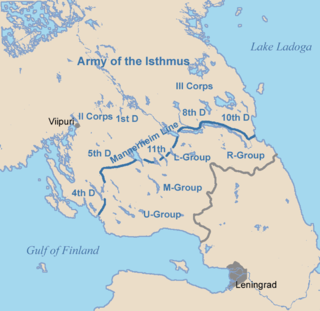The 6th Division (6.Divisioona) was a unit of the Finnish Army during the Winter War.

The Finnish Army is the land forces branch of the Finnish Defence Forces. Today's Army is divided into six branches: the infantry, field artillery, anti-aircraft artillery, engineers, signals, and materiel troops. The commander of the Finnish Army since 1 August 2017 is Lieutenant General Petri Hulkko.
The 6th Division (6.Divisioona) was a unit of the Finnish Army during the Continuation War.
The 4th Division was a unit of the Finnish Army during the Winter War. It was part of the II Corps which fought on the Karelian Isthmus. The 4th Division was responsible for the front between the Gulf of Finland and Viipuri.
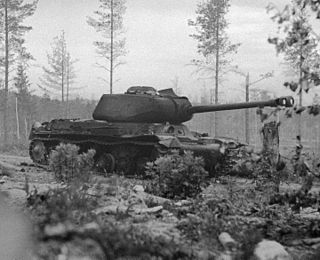
The Vyborg–Petrozavodsk Offensive or Karelian offensive was a strategic operation by the Soviet Leningrad and Karelian Fronts against Finland on the Karelian Isthmus and East Karelia fronts of the Continuation War, on the Eastern Front of World War II. The Soviet forces captured East Karelia and Viborg. After that, however, the fighting reached a stalemate.

The Battle of Nietjärvi was part of the Continuation War between Finland and the Soviet Union, which occurred during World War II. The battle ended in a Finnish victory.
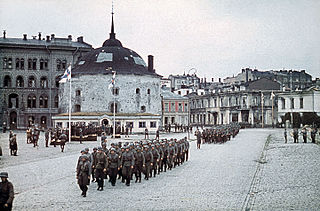
The Finnish reconquest of the Karelian Isthmus (1941) refers to a military campaign carried out by Finland in 1941. It was part of what is commonly referred to as the Continuation War. Early in the war Finnish forces liberated the Karelian Isthmus. It had been ceded to the Soviet Union on March 13, 1940, in the Moscow Peace Treaty, which marked the end of the Winter War. Later, in the summer of 1944, the Soviet Union reconquered the southern part of the isthmus in the Vyborg–Petrozavodsk Offensive.

The 44th Kievskaya of the Red Banner Rifle Division of Nikolay Shchors, or 44th Kievskaya for short, was an elite military formation of the Soviet Union.

The Battle of Tali-Ihantala was part of the Finnish-Soviet Continuation War (1941–1944), which occurred during World War II. The battle was fought between Finnish forces—using war materiel provided by Germany—and Soviet forces. To date, it is the largest battle in the history of the Nordic countries.
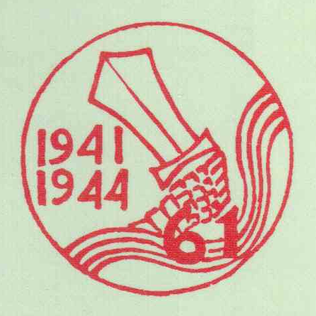
The Finnish 61st Infantry Regiment (IR61) was a combat regiment of the 17th division of the Finnish Army during the Second World War, consisting almost exclusively of Swedish speaking Finns. Among others, the regiment participated in the battle of Tienhaara. The regiment has been the subject of several books, as well as a feature film Framom främsta linjen. In 1980, Lieutenant general A. E. Martola opined: "Honestly, this regiment saved Finland during the midsummer weekend 1944, even if only temporarily."

The German 215th Infantry Division (215.Infanterie-Division) was a major military unit of the German Army that served in World War II.
The 142nd Rifle Division began service in August, 1939 as a standard Red Army rifle division, which participated in the Winter War against Finland. It remained on the Karelian Isthmus and had a relatively uneventful war facing the Finns until the Vyborg–Petrozavodsk Offensive began on June 10, 1944, from which point it saw much more active service. Following the end of the Continuation War, the division was transferred to 2nd Shock Army in 2nd Belorussian Front. Its soldiers distinguished themselves in the capture of the German city of Graudenz and ended the war fighting through Pomerania.
The 49th Rifle Division was a Soviet Army infantry division, formed three times. First formed as a territorial division in 1931, the 49th Rifle Division's first formation became a regular division by 1939 and fought in the Winter War. For its actions during the war, it was awarded the Order of the Red Banner. However, the 49th Rifle Division was wiped out during the first ten days of Operation Barbarossa. Its second formation occurred in December 1941 and fought at Stalingrad, Kursk, the Vistula-Oder Offensive and the Battle of Berlin. The second formation was disbanded in 1946. The division was reformed in 1955 by renaming the 295th Rifle Division and became the 49th Motor Rifle Division in 1957.

The 313th Rifle Division was a standard Red Army rifle division formed on July 15, 1941 in the Udmurt ASSR before being sent to the vicinity of Leningrad, first in the 7th Separate Army east of Lake Ladoga, and later in 32nd Army of Karelian Front, where it spent most of the war facing the Finnish Army in East Karelia. In consequence the division saw relatively uneventful service on this mostly quiet front until the summer of 1944, when it took part in the offensive that drove Finland out of the war. When this was accomplished, the division was redeployed to take the fight into Poland and then into the German heartland in the winter and spring of 1945. It ended the war north of Berlin after compiling a very distinguished record of service.
The 281rd Rifle Division was an infantry division of the Soviet Union's Red Army during World War II. Formed in the summer of 1941, the division fought in the Siege of Leningrad until the end of the siege in early 1944, when it advanced into eastern Estonia. The 281st was soon moved north to fight against Finland during the summer of that year, and after Finland's withdrawal from the war fought in battles in East Prussia and Poland during early 1945. The division was disbanded in the summer of 1945.
The 341st Rifle Division was first formed in September 1941, as a standard Red Army rifle division, at Stalingrad. It was a "sister" unit to the 335th Rifle Division, which was formed at about the same time and place and shared a very similar combat path in its first formation. It was assigned to the southern sector of the Soviet-German front during the winter counteroffensive, but was effectively destroyed during the German spring offensive that formed the Izium Pocket, and was soon disbanded. The division was formed again almost exactly two years later, this time in the Karelian Front, facing Finland, and saw only limited action in the Continuation War before being assigned to coastal defense duties during 1945. While the 341st had one of the shortest and least distinguished careers of any Soviet division in the Soviet-German War, it continued to serve well into the Cold War, eventually being re-designated and becoming a motorized rifle division.
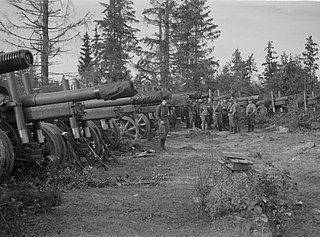
The Battle of Porlampi, also known as the Battle of Porlammi, was a military engagement fought between the Finnish Army and Red Army from 30 August to 1 September 1941 on the Karelian Isthmus. The battle was fought near the town of Porlampi during the second month of the Continuation War. The battle was a Finnish victory and effectively ended the reconquest of Karelia.

The 70th Rifle Division was an infantry division of the Red Army and briefly of the Soviet Army, formed twice.
The 368th Rifle Division was raised in 1941 as a standard Red Army rifle division, and served for the duration of the Great Patriotic War in that role. It began forming in August 1941 in the Siberian Military District. After forming, it remained in the reserves of that district until March 1942, when it was assigned to the 7th Separate Army in Karelia, where it remained until mid-1944. The division had a mostly uneventful war on this defensive front, but then took part in the offensive that drove Finland out of the war in the summer of that year, being awarded the Order of the Red Banner for its services. It later saw action against the German forces trying to hold northern Finland. The division ended the war in the Belomorsky Military District on garrison duties in the Soviet Arctic.

